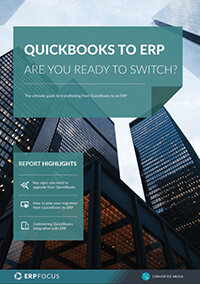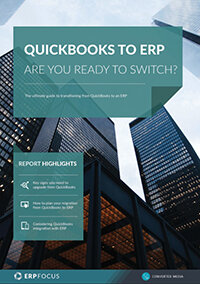Why small businesses upgrade from QuickBooks to ERP
We’ve all outgrown things in our lives, from shoes and clothes to that first tiny flat and now, for many of you, entry-level accounting software. As we and our small businesses age and grow, things get more complicated and we’re able to reach further, but need a hand achieving our best.
If your business has become complex and is using its financial information for much more than just paying the bills, it might be time to expand to an ERP, leaving QuickBooks behind. To figure out if that’s the right move for you, here are four of the most common reasons that small businesses upgrade from QuickBooks to a full ERP.
Data becomes a bottleneck
QuickBooks can automate some data entry and aggregation, but your standard ERP is significantly stronger in this aspect. ERPs reliably import and verify data much faster and with tools that are generally easier to use, allowing you to avoid things like manual entry.
Avoiding errors in your books and operations is always a worthwhile advantage. ERPs come out ahead here because of their ability to work with more systems — accounting and beyond — to properly manage, aggregate, and understand the data you have.
Picking a top-tier option will also give you one system and interface to manage more of your workforce, materials, and other resources that are used across different business operations. An ERP is an acknowledgment that your small business has grown beyond what silos can hold.
Industry needs grow
A company expansion from QuickBooks to a top-tier ERP happens when a business needs the additional features that a system-wide understanding brings. Among the most common examples of this is when a manufacturer wants to run their production lines from a single system.
An ERP will allow you to consider material constraints, processes, tooling priorities, BOMs, and more for your standard production. It’ll also help you ensure you’ve got additional items and capacity needed in the event of an emergency.
Forecasts and analytics can’t change fast enough
A significant shift in your operations can occur at any moment. When the tsunami hits, no matter what it is, your planning must change. Unfortunately, for most enterprises and large businesses, using QuickBooks means you’ll have a few steps and data transfers that must occur before forecasting tools get the latest info.
When an import goes wrong, then you’ve got a longer wait — or a significant issue if you don’t realize the data hasn’t transferred correctly.
Upgrading to a large ERP usually means getting built-in analytics and forecasting tools that executives and your business depend on each day. Understanding your financial growth potential impacts all future decisions, and you don’t want anything slowing that down.
You live in a workaround city
Our final thought comes from a disgruntled CPA ahead of a tax season. She was supporting clients and auditing books ahead of filing and kept finding hidden data, customer information, or shifted accounts. People had been using QuickBooks for longer than they should and had ultimately weaved a complex web of workarounds that made an outside review time-consuming and costly.
If you’ve got your own list of tips to get around QB’s limitations — especially if they get in the way of your management or integration with partners and other software — it’s time to graduate to a tier-1 financial service.
Your entire team will thank you for it.
Free white paper

Quickbooks to ERP: Are You Ready to Switch?
Get the definitive guide to converting your business from Quickbooks to ERP

Featured white papers
-

Quickbooks to ERP: Are You Ready to Switch?
Get the definitive guide to converting your business from Quickbooks to ERP
Download
Related articles
-

QuickBooks vs ERP: What ERP does better
Could your accounting & inventory management benefit from upgrading to ERP?
-

Secret KPI: Why Your ERP Implementation Team Matters More Than Software
Learn how Godlan ensures successful ERP implementation for manufacturers with proven strategies &...
-

Are any ERP alternatives as effective as ERP?
There are all kinds of ERP alternatives out there - but how do they measure up to the real thing?

